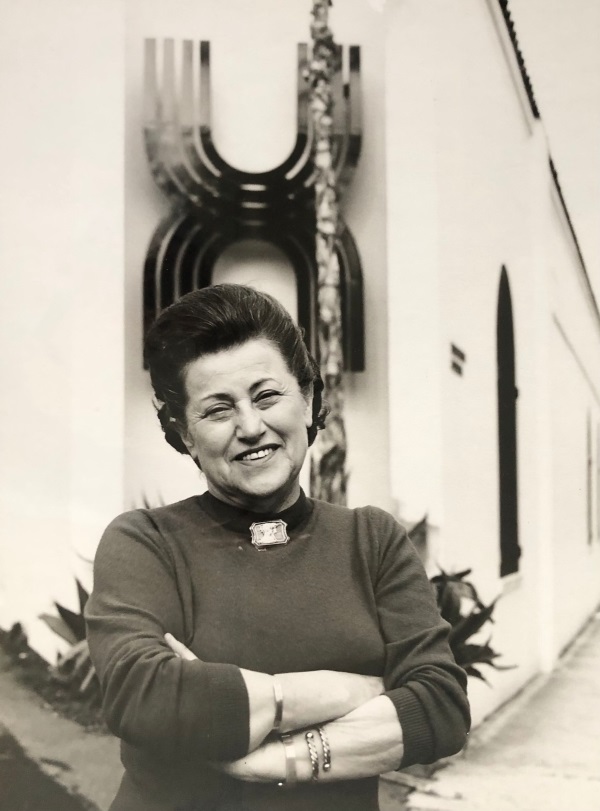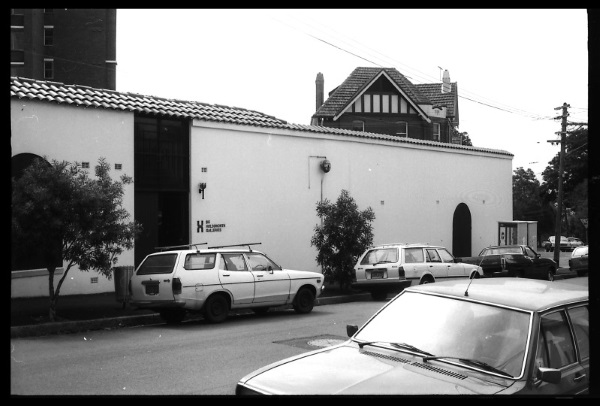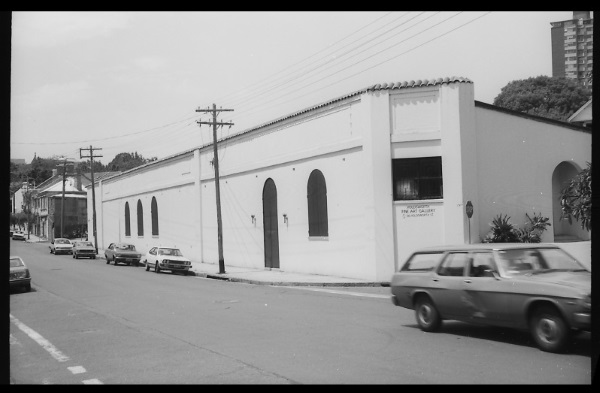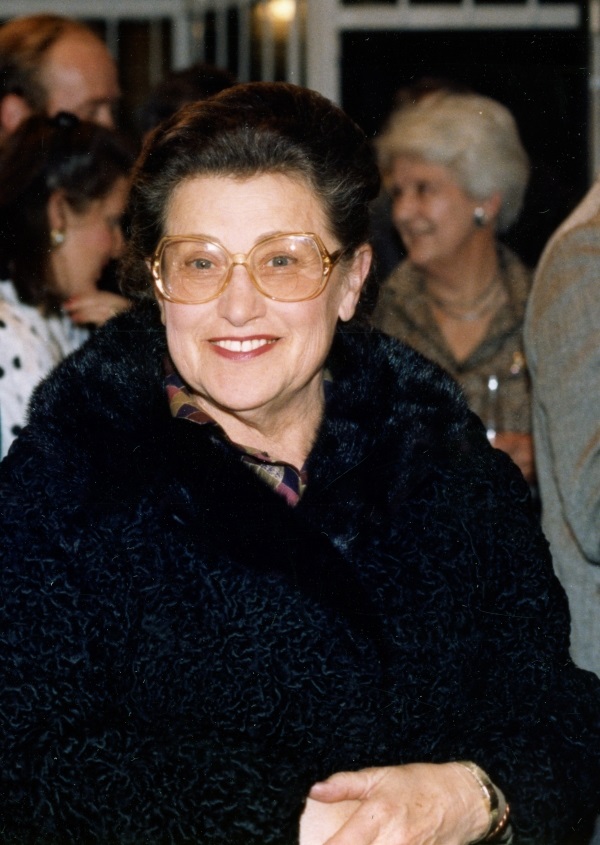Gisella Scheinberg OAM
1921-2018
Art dealer and curator
Gisella Scheinberg was a leading, successful commercial gallery operator, a hardworking and astute businesswoman and a great supporter of artists, both established and emerging. She showed great resourcefulness and courage throughout her life particularly during the war years and she treasured her family and friends.

Image: Gisella Scheinberg outside the Holdsworth Galleries. Image courtesy of Gisella’s family.
Plaque location
96 Holdsworth Street, Woollahra
View all plaques in Woollahra
Gisella Scheinberg (nee Blum) was born on 12 June 1921 in Budapest, Hungary, the second daughter of 4 children. She grew up in a traditional Jewish family, with memories of a happy childhood living above the family’s liquor and grocery store. She was a brilliant mathematician and excellent swimmer and studied Fine Arts at University. Her studies were cut short with the outbreak of World War II during which time she spent many months in hiding. She escaped concentration camps and worked for the communist resistance and when necessary used these connections to help safeguard both herself and her family. Gisella’s two younger brothers survived the War but Gisella’s older sister had died in New York before war broke out, and her mother and grandmother both died during the War. After the War Gisella married William Jakob and, sponsored by Albert Scheinberg, they left Hungary for Australia, arriving in 1948.
Albert Scheinberg came to Australia from Hungary in 1939. He forged a successful business career, founding (with architect Ervin Graf) the company Stocks & Holdings (later Stocklands) in 1952. He was a supporter of refugees from Europe, sponsoring many to come to Australia.
Once in Australia Gisella gave birth to a son George and worked as a seamstress with William, a tailor. After her marriage to William ended she took a position as a bookkeeper working with Albert Scheinberg. Albert and Gisella married in 1955 and they had two children, Richard and Deborah.[1] Albert had three children from a previous marriage. Nurturing and supporting her family was of paramount importance to Gisella throughout her life. In 1961 Albert and Gisella purchased the family home at 438 Edgecliff Road, Edgecliff, which would be the scene of many family, social and fund-raising gatherings.[2]
During the 1950’s and 1960’s Gisella continued working in business with Albert. By the mid 1960’s Gisella was looking to start her own business concern. Influenced by her interest in art and her capabilities as a businesswoman, she began to make plans to establish a commercial art gallery. In 1968 she took over a property housing an old disused factory building at the corner of Holdsworth Street and Jersey Road in Woollahra. The factory had undergone a variety of uses from commercial laundry to brush works and finally a telephone plant. Gisella set about converting the building to an art gallery which, after its opening, was described as being ‘very large, excellently lit and appointed’.[3] The gallery was opened as the Holdsworth Galleries at a gala event on 20 September 1969. This was followed by the Galleries’ inaugural exhibition of the first Australian display of the works of Helen Marshall and Phillip Martin opening on the 22 September.[4]

Image: Woollahra Field Survey 1982, Holdsworth Street, Woollahra

Image: Woollahra Field Survey 1982, Corner Jersey Road and Holdsworth Street, Woollahra
In 1971 major extensions to the gallery were planned by Gisella and architect Stephen Gergely of Gergely & Pinter, with the intention of enlarging the gallery space and creating an area for permanent display. Plans included provisions for a larger gallery area, the addition of a print room, storage area and coffee lounge, and the creation of a central courtyard for the display of sculpture.[5] On 8 October 1973 the ‘splendid three salon gallery and restaurant extensions’ opened along with an exhibition of paintings by Sali Herman.[6]
Gisella employed a full time manager and a part time assistant and the gallery was initially open daily from 10am to 5pm apart from Sundays, with hours extending to 8pm on opening nights.[7] Before long the gallery was opening 7 days a week with exhibitions changing every three weeks.[8] As well as the constantly changing exhibitions and promotions of displays, Gisella opened the gallery for charity and fund raising events such as musical evenings and lectures, and as a place to welcome visiting dignitaries and for use by clubs and societies. In 1974 the Galleries housed a major exhibition of archaeological finds and reconstructions of musical instruments from 3000 BCE to the Byzantine era.

Image: Advertisement for Holdsworth Galleries
Gisella’s skills as a business woman, her dedication, knowledge of art and her encouragement of artistic talents ensured the success of her enterprise. The Holdsworth Galleries became a respected and much sought after institution in the art world. Many of Australia’s best known contemporary artists such as Ray Crooke, Judy Cassab, Sali Herman and Robert Dickerson exhibited at the gallery.
The Holdsworth Contemporary Galleries at East Sydney was another of Gisella’s ventures, established in 1985 with the aim of supporting and promoting emerging artists. The Galleries hosted at least 200 shows of three artists per month, as well as survey shows such as the Bicentennial Exhibition of Sidney Nolan and The Art of Collage. Gisella again donated the gallery space for fund-raising and functions. The Contemporary Galleries held its final exhibition of works by Barbara Cohen, Kay Faithful, Gregory Wilding and Marilyn Nash in March 1989.[9]
Gisella was the director of the Holdsworth Galleries from its inception in 1969 until her retirement and the closure of the gallery in 1996. During this time she exhibited the works of over 900 artists at her galleries. At her last show at the Holdsworth Galleries held from September-December in 1996, she exhibited over 600 paintings, prints and sculptures by artists such as Charles Blackman, Arthur Boyd, Donald Friend, Robert Dickerson, Ray Crooke, Patrick Hockey and Robert Juniper. Speaking of her years at the Galleries’ helm she said:
I loved it. I am so fulfilled. I lived in it, it developed with me; I developed with it. I understand every bit of it, and I loved every bit of it.[10]
After Gisella sold the Woollahra property in 1996, the site was re-subdivided and the building was demolished for residential and commercial development to a design by architects Gergely & Pinter.[11] The re-numbered property, 86 to 98 Holdsworth Street describes the land area associated with the former Holdsworth Galleries, while its history is preserved in an archive of some 7000 files held by The National Library.[12]
There are numerous examples of Gisella’s acts of kindness and the generosity she offered to many. She provided practical and emotional assistance to artists, such as financial advances and through her belief in and encouragement of their work. She was of particular support during the AIDS crisis and helped others through personal crises and in times of need. She believed that when she accepted an artist she accepted them as part of the family.
I have many wonderful memories but there were also the dark times. I helped artists through drug and alcohol problems – some I have not been able to help – and some through marriage breakdowns.[13]
Gisella was a generous benefactor to the arts, donating a large print collection to the Maitland Regional Art Gallery and supporting programs that the gallery ran. A room at the Maitland Regional Art Gallery was named in recognition of her ongoing support. She also gifted a number of works to the Art Gallery of NSW and supported the National Gallery of Australia financially.[14] An art building at Moriah College is named in her honour.
Gisella was heavily involved in fund-raising activities and frequently opened her home and the gallery for fund-raising events. Gisella and Albert both participated in fund-raising and contributed to various causes and organisations such as the United Israel Appeal, the Jewish Communal Appeal and the Friends of the Hebrew University.[15] She was an important donor to the Maitland Jewish Cemetery Project. She was a Foundation Life Governor of Montefiore and contributed towards the establishment of the Shalom College at the University of NSW.[16] Gisella also raised funds for and contributed to various foundations and charities such as the Children’s Surgical Research Fund, the Deaf and Blind Children and the Children’s Hospital among others.

Image: Gisella Scheinberg at the Holdsworth Galleries, 1987. Image courtesy of Gisella’s family.
On 26 January 1985 Gisella was awarded the Medal of the Order of Australia for her services to the Arts.
After her retirement Gisella cared for her husband Albert. She maintained an active life, caring for family and continuing the practice of regular Friday night family dinners, producing craft works and carrying on with her philanthropy. After Albert’s death on 30 December 2008 at age 96, Gisella entered the Montiefore Care Home. During this period she engaged in social and cultural activities, and her family continued to be of enormous importance to her. Gisella died in Sydney on 4 October 2018, aged 97.
Australian Dictionary of Biography
Births Deaths and Marriages NSW
Emissaries of trade: a history of the Australian trade commissioner service
Historic Land Registry Services
Griffiths, G. Nesta, Some people and houses of NSW, Ure Smith, 1949
NLA Trove Database
Sands Sydney Directory
Schedvin, Boris, ‘Emissaries of trade: a history of the Australian trade commissioner service’, Barton, A.C.T., Dept. of Foreign Affairs and Trade, 2008
Woollahra Council archives – building registers; rate and assessment books; minute books; subdivision plans
Ginahgulla Road, Bellevue Hill, No. 9, ‘Trahlee’. Woollahra Libraries Local History Research File
Sheldon Place Reserve (David Joel Reserve), Bellevue Hill. Woollahra Libraries Local History Research File
Footnotes
1 Debbie Redelman and Jacqui Scheinberg, ‘Gisella Scheinberg (1921-2018)’, Obituaries Australia, National Centre of Biography, Australian National University, https://oa.anu.edu.au/obituary/scheinberg-gisella-28248
2 Certificate of Title Vol. 3523 Fol. 171
3 ‘Coherent exuberance’, Australian Jewish Times, 2 Oct 1969, p. 4.
4 ‘Once in a year night’, Now (Potts Point, N.S.W. : 1968-1975), 23 Sep 1969, p. 7.
5 Woollahra Council Minutes 6 Dec 1971, p.3271-3275, DA102/71
6 ‘Exposure breeds familiarity’, Australian Jewish Times, 26 Sep 1973, p. 52.
7 Ibid p.3272
8‘Gallery to close’, Sydney Morning Herald, 3 Jun 1996, p. 16.
9 ‘Holdsworth Contemporary Gallery closes’, Australian Jewish Times, 3 Mar 1989, p. 25
10 ‘Tears as gallery owner holds her last picture show’, Sydney Morning Herald, 5.10.1996
11 Foundation Annual Report 2015-16, National Gallery of Australia, p. 24
12 ‘A Living example’, Australian Jewish Times, 1 Aug 1974, p.15.
13 Montefiore Annual Report 2014-15, p. 43
14 Foundation Annual Report 2015-16, National Gallery of Australia, p. 24
15 ‘A Living example’, Australian Jewish Times, 1 Aug 1974, p.15.
16 Montefiore Annual Report 2014-15, p. 43
Nominate a person or event
New plaques are added based on nominations from the community, which are then assessed against selection criteria and researched by a Local History Librarian.
Find out more and nominate a person or event for a plaque.